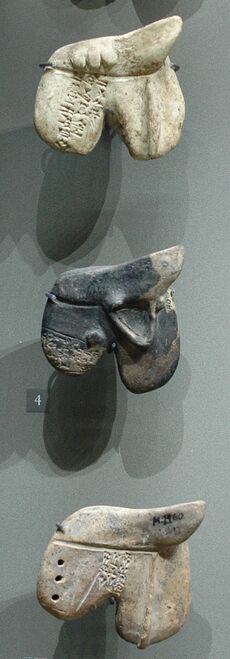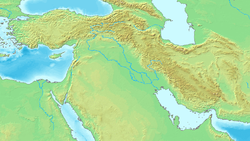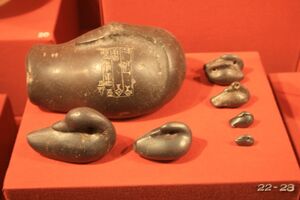ميتوران
| الاسم البديل | Me-Turnat |
|---|---|
| المكان | محافظة ديالى، العراق |
| المنطقة | بلاد الرافدين |
| الإحداثيات | 34°12′52″N 45°5′5″E / 34.21444°N 45.08472°E |
| الارتفاع | 6 m (20 ft) |
| النوع | مدينة قديمة |
| الارتفاع | 6 متر |
| التاريخ | |
| الفترات | إيسين-لارسا، البابلية القديمة، Kassite، الآشورية الحديثة |
| ملاحظات حول الموقع | |
| تواريخ الحفريات | 1978 - 1984 |
| الأثريون | نائل حنون و برهان شاكر |
| الحالة | خربة - مغمورة |
مى-توران (Me-Turan ، أيضاً Mê-Turan) is an archaeological site in Diyala Governorate Iraq comprising the modern Tell Haddad and the two mounds of Tell al-Sib (also Tell as-Sib). In Neo-Assyrian times it was known as Me-Turnat. It was excavated as part of the Hamrin Dam salvage project. [1]
التاريخ
The city of Me-Turan was occupied in the Isin-Larsa period (Level 4), Old Babylonian period (level 2 and 3), Kassite period, and Neo-Assyrian period (level 1). Founded early in the 2nd millenium BC during the Isin-Larsa times it was controlled by Eshnunna through the reign of several of that cities kings. With the rise of Babylon Me-Turan came under the control of that city. After the end of the Old Bablyonian period the city lay fallow until Neo-Assyrian times, excepting some Kassite era residencial housing.[2] At the surface were nine Parthian kilns.[1]
الآثار
Tell Haddad is a 6 meter high tell and the largest site in the area after Tell Baradan which it lies 350 meters east of. The two nearby smaller mounds of Tell al-Sib are smaller. Together they formed the ancient city. Excavation at Tell al-Sib began in 1978 when a number of tablets and a gaming board were found.[3] The full site was excavated by Na'il Hannoun and Burhan Shakir beginning in 1979. Work ended in 1984 when the site was flooded. In total around 1000 cuneiform tablets were recovered with 745 being from Tell al-Sib. At the lowest layer, above virgin soil, a jar was found with 34 tablets containing year names of three kings of Eshnunna, from before the area was conquered by Babylon.[4]

In Old Babylonian times the city was surrounded by a four meter wide city wall with towers. Finds from the Old Babylonian period include a duck weight, two extispicy liver models, and large number of cuneiform tablets and fragments. A number are in Akkadian, mostly of economic content but including medical, mathematical, and incantation texts. One of the mathematical tablets (IM 95771) includes a problem about a trapezoidal water reservoir divided into five sections of equal length.[5] The remainder are written in Sumerian and include literary texts such as Gilgamesh and the Bull of Heaven as well as a new fragment of the Laws of Eshnunna. Kassite period housing was excavated.[6] A Neo-Assyrian temple dating to the reign of Ashurbanipal, E-šahulla dedicated to Nergal was found. The temple dimensions are 80 meters by 47 meters and it was destroyed by fire. An inscription of Sargon II was also found.[7][1][8][9][10]
المراجع
- ^ أ ب ت Mustafa, Abdul-Kader Abdul-Jabbar (1983). The Old Babylonian tablets from Me-Turan (Tell al-Sib and Tell Haddad) (PhD).
- ^ Killick, Robert, and Michael Roaf, "Excavations in Iraq, 1981-82.", Iraq, vol. 45, no. 2, 1983, pp. 199–224
- ^ Postgate, John Nicholas, and Philip J. Watson, "Excavations in Iraq, 1977-78.", Iraq, vol. 41, no. 2, 1979, pp. 141–81
- ^ Killick, R., and J. Black., "Excavations in Iraq, 1983-84.", Iraq, vol. 47, 1985, pp. 215–39
- ^ Friberg, J., and F. Al-Rawi. 2016. New Mathematical Cuneiform Texts. New York: Springer
- ^ M. D. Roaf and J. N. Postgate, "Excavations in Iraq 1979-80", Iraq, vol. 43, pp. 167-198, 1981
- ^ Al-Rawi, F. N. H. (1994). "Texts from Tell Haddad and elsewhere". IRAQ (in الإنجليزية). 56: 35–43. doi:10.1017/S0021088900002795. ISSN 0021-0889. S2CID 191355863.
- ^ Muhamed, Ahmad Kamil (1992). Old Babylonian cuneiform texts from the Hamrin Basin Tell Haddad (in English). London: Nabu. OCLC 640257618.
{{cite book}}: CS1 maint: unrecognized language (link) - ^ Cavigneaux, Antoine; Al-Rawi, Farouk (1993). "New Sumerian Literary Texts from Tell Haddad (Ancient Meturan): A First Survey". Iraq. 55: 91–105. doi:10.2307/4200369. ISSN 0021-0889. JSTOR 4200369. S2CID 191399328.
- ^ Hanoon, N. (1982). "Baradan, al-Seib and Haddad Tells". Sumer. 40: 70–71.
للاستزادة
- Hanoon, N. 1982. Tell al-Seeb and Tell Haddad, BSMS 2, 5-6.
- Sulaimman, B. S. 2003-04. Results of Prospectings in Tell Haddad, Sumer 52, 89-143
- Dr. Fawzi Rashid, " A Royal Text from Tell Haddad ", Sumer 37 (I98I), I OI-I I I (Arabic Section)
- Al-Juboury, Reyadh Ibraheem MA. Unpublished Cuneiform Texts From the Old Babyloian Period-Tell Al-Seeb. Diss. UNIVERSITY OF BAGHDAD, 2019


